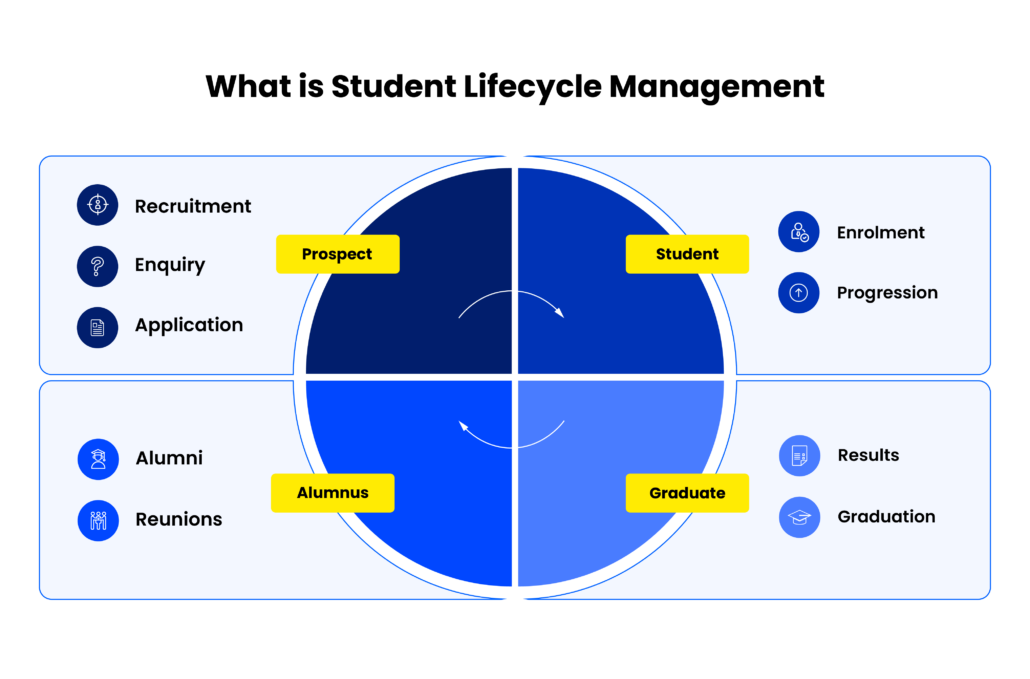The higher education market is facing fierce competition with each passing year. Recruitment heads and marketing teams face constant struggles to keep up with the targets while trying to streamline their internal processes.
At the same time, most students only get to interact with the higher education institute post enrolment. But they need to be supported throughout the admission process, right from choosing an appropriate course. Students invest so much—mentally, physically, and financially—they need a constant support system throughout this journey.
This is where a cutting-edge and well-integrated student lifecycle management (SLM) platform comes into play.
This article helps you understand how student lifecycle management elevates a student’s journey from inquiry to alumni.
What is Student Lifecycle Management?
Student lifecycle management is the process of capturing and tracking every interaction that a higher-ed institute has with the student. It spans the entire student lifecycle, right from capturing interest to organizing reunions for alumni.
It is a data-driven approach that helps the university drive engagement and retention for successful student journeys.

Let’s deep dive into why institutions should invest in a Student Lifecycle Management (SLM) software.
Importance of Student Lifecycle Management in Higher Education
In this section, we share why a university should invest in a well-rounded student lifecycle management strategy. Besides helping the university get a 360-view of student engagement; it also streamlines internal processes to build a data-driven approach.
1. Boosts Performance and Graduation Rates
With a Student Lifecycle Management software in place, the university can identify when a student is facing any difficulties or requires extra support to cope with the course workload. Universities can help students with peer or teacher interactions or through working on live projects.
An SLM system helps universities evolve into the support system a student needs rather than having a “one model fits all” approach.
And because the student feels “heard”, and their “needs” are met with tailored solutions, graduation rates and performance accelerate! Streamlines Processes and Increases Efficiency
Processes like building touchpoints throughout the student journey and automating communication are all streamlined with student lifecycle management.
Limiting human intervention, only to important tasks, ensures counsellors and professors spend their time building better experiences for students.
In one of our webinar interactions, Eddie Cook, Corporate Director of Admissions, Asher College shared how technology helps his team focus more on building relationships and trust with the students.
“Leveraging technology like LeadSquared frees reps’ time to ease student onboarding and tackle bumps and bruises of the course duration. The best students you are going to capture is through referrals and you’ll only get those when you build that relationship and trust with the students.”
– Eddie Cook, Corporate Director of Admissions, Asher College
2. Improve Customer Service
As you streamline your processes, you start understanding the student journey, their questions, common concerns that surface, and more with data.
You can differentiate between queries that can be solved through an FAQ section and the ones that require a forum for peers to interact. This helps you be better prepared for the process to resolve student queries faster.
Which brings me to the next point.
3. Improve Student Experience and Attrition Rates
When you can engage better, resolve queries faster, and help a student overcome challenges that they might not even be aware of yet, it builds a stronger relationship. And this ensures that students don’t drop off, during enrolment or the early stages of their course, due to poor experiences.
Driving better experiences is what helped Bobby’s team identify and approach students with retention as their end goal.
“There is a diverse number of next-gen students, and they should be approached from the angle of retention rather than recruitment. It’s important to understand their needs and seek that common theme that ties it together”
– Bobby Babbrah – Managing Partner and CEO, Flipp.ed Ventures LLC
4. Boost Student Retention and Recruitment Efforts
There is a cost implication attached to every effort of acquiring students, enrolling them, and teaching them. A Student Lifecycle Management helps you improve the ROI of the efforts you put in.
Over time, the data generated will help you identify the students that have a higher chance of graduating, build personalized pitches to suit the student’s needs, and enable the professors as well.
5. Increase Student Engagement and Satisfaction
It is all about making the student feel understood and heard. If you can guide the students better, improve their college experience, and meet their needs, then they are bound to have a good experience.
Understanding what students really need and fueling their ambitions encourages them to become ambassadors for your college.
5. Manage Change and Track Progress
Student Lifecycle Management extends beyond student communication, the framework also involved sharing important cues with the counsellors. Institutes can monitor processes, performance, and interactions seamlessly.
With all your systems integrated, it is easier for you to track, measure and take corrective action in due course of time.
6. Improve Collaboration and Reporting Capabilities
One of the major reasons why processes break down is because cross-functional communication is missing. In traditional processes, silo-ed communication often occurs during hand-offs between different stakeholders.
When different stakeholders work together on the same or integrated platform, it ensures visibility from the grassroots to the management level. And this helps improve collaboration and reporting among different stakeholders.
Now that you know why it is important to have a student lifecycle management process, let’s look at its key stages.
How to Manage Key Stages of Student Lifecycle
Here are the key stages that require intervention and interactions from an institution during the student’s journey.

1. Pre-admission
This is the acquisition stage—where the institute needs to convince the student why they are the right choice for them. It’s also where you strike a balance between automating education workflows and counsellor interactions with your students.
Your SLM platform should be able to:
- Qualify incoming inquiries
- Assign the right counsellor based on student interest
- Help counsellors understand and personalize pitches
- Disseminate important information and alerts to move the student to the next stage
2. Enrollment
At this stage, the student needs help with course details, class schedules, books, and instructor information to set expectations for their near future.
Communication can be easily segmented, and professors or counsellors only intervene on a case-by-case basis.
Your student lifecycle management platform should:
- Share detailed course information with students
- Help them maintain their class schedules
- Guide them to select elective courses
3. Learning Experience
This is the make-or-break stage. The student has been successfully onboarded but is also scrutinizing the expectations you had set during the process.
This is where the SLM platform helps you:
- Engage with students better
- Identify “at risk” students
- Build relationships with instructors
4. Performance Management
As mentioned earlier, the SLM platform helps an institute improve interactions and visibility across all stakeholders—students, counsellors, recruitment heads, instructors, and management.
An end-to-end student lifecycle management platform helps institutions:
- Manage the overall team performance
- Track engagement levels with students
- Take faster data-driven decisions
5. Graduation
At this point, the student’s expectations and needs are finally met. They are hoping to either start their career or get the next big jump post their learning experience.
Here the role of your student lifecycle management system should be that of an administrator. It should help students:
- Collect professor recommendations
- Access transcripts and certificates
6. Employability Efforts
Here’s when the real test begins: the students have met their goals and now are on the path to bearing the fruits of labor.
Your SLM system should play the role of a trainer to:
- Help them prepare for interviews
- Share different career opportunities
- Connect with alumni
7. Alumni Management
The journey of a student doesn’t end at graduation. An institution earns its status with the kind of alumni it produces. Harvard didn’t become an ivy-league just by engaging with its students better or having a consistent process. It got its name through the success of its students in the field of governance, politics, business, and more.
Here the SLM platform becomes that friend who ensures the group of friends meets every year. It should help you:
- Organize reunions
- Build communication between different graduates
- Engage through placement in alumni companies
- Celebrate rewards and recognitions of past students
Now let’s look at some of the best practices to implement for better student lifecycle management.
9 Best Practices for Student Lifecycle Management
Here are 9 best practices that will help you elevate your SLM strategy. So, take notes and start implementing these:
1. Creating an Engagement Strategy for Each Stage
Every stage requires a different approach to engagement. Some need email interactions while other stages require a team member to intervene. Identify the needs of the student at each stage and then personalize their communication journey.
This is where talking to stakeholders that interact with the students, students that have gone through the process, and recent graduates with positive experiences can help you out.
2. Automating Email Campaigns
With the right marketing automation technology, it is possible to personalize email campaigns at scale. Email campaigns like deadline reminders, follow-up alerts, course timetables, etc., can be sent out through templatized emails and nurturing sequences.
3. Focusing on Millennials and Generation Z
There are a diverse group of students that come to university—some are fresh high school graduates while others are looking to go back to studies and upskill. Millennials and Gen Z need to be approached through different channels and require different kinds of interventions.
A Gen Z student looks for instant gratification and would be happy chatting with a bot to get faster responses.
While a millennial needs a longer set of instructions and multiple conversations to resolve their queries. They would prefer getting in touch with a human at the first interaction.
4. Implement a CRM to Capture, Manage, and Share Data
Your processes are only as good as the information you capture and share across each stage. Having an end-to-end Education CRM to capture student data, send out communication, map different stages, and integrate data from different platforms helps you scale faster.
The qualitative insights and quantitative data enables you to make decisions and improve student experiences with ease.
Here are 5 ways you can leverage an Education CRM to improve student onboardings and experiences:
- Set-up automated workflows for lead assignment and communication
Leverage multiple admission workflows like automated lead assignment, sending out welcome emails, and sending out reminders & notifications to students and counsellors.
- Drive paperless admissions
Drive your application process through native portals to collect and verify documents, send out real-time notifications to counsellors to improve completion rates, and keep students updated with the next steps in the application process.
- Send out omnichannel communication
Use a single system to send out communication across channels. Make it easier for your counsellors and students to interact with each other on their preferred channels of communication.
- Track student activity
Every student journey is different and has different requirements. For your counsellors to provide a truly personalized experience, they need to know the student’s journey from discovery to onboarding. An education CRM helps you map these journeys and empower your counsellors.
- Track team and channel performance in real-time
You are only as good as the numbers you produce. Tracking your data has become more important in today’s digital age than ever before. With a CRM system in place, you will be able to track performance based on different teams, sources, and channels you use to generate inquiries.
5. Optimize Your Online Presence
Whether it is Gen Z or a millennial, both are present on various online channels. It is important to not only be present on different online channels but also customize your messaging to be discovered and heard in this competitive world.
Customizing messaging based on the target helped Grace David, CEO, Edukasyon—a K12 edtech company in the Philippines, ace her acquisition goals.
“While approaching the end users, we Gen-Zfied our messaging so it reaches them in a language they understand. For the transactional aspects, we created another message that reached those decision makers.”
– Grace David, CEO, Edukasyon
6. Engage Alumni Through Organizational Participation
As mentioned earlier, you only get as big as the students that graduate from your institution. In order for them to appreciate being associated with you, it is important for you as an institution to recognize their achievements and engage with them better.
Organizing recognition ceremonies, inviting them as keynote speakers, organizing placement activities and internships in their companies, etc., is what will help the alumnus stay in touch with the institution.
7. Develop a Strategy to Engage Students from the Beginning
Build a communication strategy with a higher degree of personalization that helps elevate engagement levels from the beginning. From setting up automated “Welcome emails” to IVR messages, ensure to be in touch with the student at every stage. This will help you grow your engagement level with each stage.
8. Develop a Mechanism to Capture Feedback from Students
At the end of the day, no amount of inferences and number crunching will help you build a seamless student lifecycle management process. A big part of that process should be having insights straight from the horse’s mouth.
Taking feedback from students is what helped Mickey Baines, Kennedy & Company, train his team better.
“It is important to be prescriptive while deploying any tactic. In terms of collecting data, training staff, and sharing feedback for any approach to be more effective.”
– Mickey Baines – Partner, Kennedy & Company
9. Integrate systems for e-learning, admissions, and payment
One thing you shouldn’t compromise with while buying SLM software is the level of integration it provides. It is not necessary for an SLM software to cater to all the stages in the student lifecycle, but a holistic tool would be able to integrate and share information with the different tools you use across stages.
And this helps us segue to the next section! The tools and tech-stack an institution can use to manage student lifecycle.
Tools and Technologies for Student Lifecycle Management
Student lifecycle management encompasses different systems that need to be integrated and automated to share information seamlessly with each other. In this section, we will share the tools and technologies every institution should have to manage student lifecycle.
1. Customer Relationship Management (CRM)
This will help you manage the firsttwo stages of the student lifecycle—pre-admission and enrollment. A CRM helps you capture, manage, and track the onboarding interactions you have with the prospective student.
Tool recommendation: LeadSquared Education CRM | Starts at $25 per user/month
Top features – Student journey builder, applicant portals, payment & dialer integrations
2. Cloud ERP
A cloud ERP helps you integrate and automate operational business functions by creating access over the internet. It ensures business continuity by giving you the ability to analyze data in real time.
Tool recommendation: Ireava | Starts at $25 per month
Top features – Lesson planning, online assessment
3. Learning Management System (LMS)
A learning management system helps you plan, implement, and assess a specific learning process. It enables the student to learn from anywhere and at any time. It also helps the instructors can also interact and solve doubts that students might have about a particular topic.
Tool recommendation: 360Learning | Starts at $8 per 100 users
Top features – Off-the-shelf content, Zoom integration to host online lessons
4. Student Information Systems (SIS)
This is the holy grail directory of student information—contact details, attendance records, grades, class schedules, payment history, and more. It helps you maintain a detailed student engagement history.
We recommend investing in an integrated CRM and SIS system that integrates seamlessly to ensure no student information is missed.
Tool recommendation: CampusNexus | Starts with a custom plan
Top features – Student directory, Behavorial badges
Conclusion
Ensuring a student’s successful journey requires multiple touchpoints and stakeholders to interact and share information with one another. For effective student lifecycle management, you need to have the right processes, tools, and engagement in place. It not only helps you realize your recruitment goals but trickles down to retention as well as maintaining a healthy relationship with your alumni.









